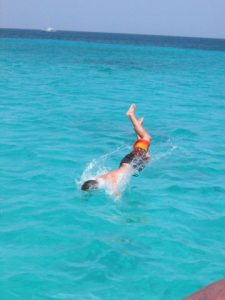
Overcoming the Opressive Heat.

Ah, Summer. We waited so long for you. We thought of you as we watched friends’ cars get stuck in snowdrifts, as we found ourselves being an hour late to work by no fault of our own, and as we updated our collection of fleece jackets and UGG boots. Spring went by in a blink and then Summer settled in. It feels like we had about a week of nice weather before we had our streaks of heat. First just a day or two, now it’s weeks at a time and even Metro relented and allowed the population to carry water bottles and drink on the metro lest they pass out while walking up the broken escalators. You know it’s hot when Metro concedes.
For people walking or exercising in the heat, our main concern is hyperthermia, an elevated body temperature. Body temperature rises naturally with exercise as the muscles produce heat. This is offset with sweat and an increased breathing rate. Since the body is at most 20-30% efficient, 70-80% of the energy expended during exercise appears as heat (Powers S, Howley E, pg 223). Being that we live on the East Coast (I miss my West Coast!), we need to worry about the relative humidity as well. A high relative humidity reduces the vapor pressure gradient between the skin and the environment. On a hot/humid day, like today, the vapor pressure in the air is close to the vapor pressure on moist skin; therefore, the rate of evaporation is greatly reduced. High sweat rates during exercise in a hot/humid environment result in useless water loss. Sweating does not cool the skin, evaporation does. Without evaporation, our body temperature rises until we must stop or our body forces us to stop!

This is why we athletic trainers never let athletes train with a fever. We also have a saying, “At 85 and 85, stay inside to stay alive”. Meaning at 85 degrees with 85% humidity, your body can’t cool down with evaporation, so just stay inside. This is also why we acclimitize our athletes to heat.
Heat acclimation results in a lower heart rate and core temperature during submaximal exercise. Ideally, I like to use 2 weeks to become heat acclimatized. I think back in March on an 80 degree day I was melting, and now 80 degrees would be a cool day. Starting at 15-20 minutes of exercise, go in the morning when its cooler, 6 or 7 am. Work up to your desired amount of cardio (45-60 min?). Then, after 3 days, start going at later times of day, like 9-11 am. Cut back on time, back to 15-30 min, and work up to 45-60 in 3 days. Then the tough part, working out at the hottest time of the day, 1-4pm. Again starting at 15-30 min and working up to 45-60 min, taking short breaks in the shade if needed. Again, this process takes a few weeks and it is UNCOMFORTABLE.
Here are the changes that occur in the body with proper acclimation:
- Increased plasma volume
- Earlier onset of sweating
- Higher sweat rate
- Reduced sodium chloride loss in sweat
- Reduced skin blood flow
- Increased heat shock proteins in tissue
Core temperature and variations in sweat rate are also affected by the following characteristics:
- Height and weight – heavier people sweat more
- Degree of acclimation – well acclimated people sweat earlier and more
- Fitness level – fit people sweat more
- Hydration status
- Environmental conditions
- Clothing
- Intensity and duration of activity
- Heredity
Loss of adaptations are rapid, with reductions in heat tolerance occurring within a few days of inactivity. Repeated exposure to heat is required to maintain heat acclimitization.
So, in summary. Be careful, stay hydrated, acclimatize yourself and take breaks if needed. Remember, I have your back